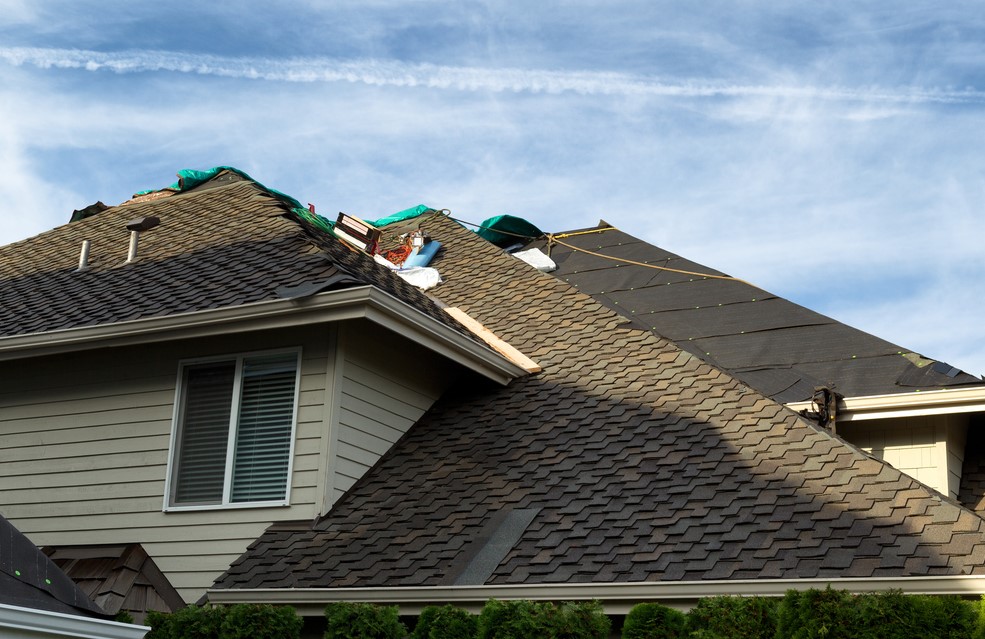Roof replacement costs in Calgary vary significantly depending on the roof’s size, pitch, shingle type, and attic ventilation needs.
Asphalt shingles typically provide the best value in Calgary, whereas metal and rubber shingles contribute to an extended lifespan in areas prone to hail and freeze-thaw cycles.
Angel’s Roofing provides 25+ years of local expertise, transparent estimates, and secure teams.
Anticipate high-quality materials, clean locations and reliable warranties.
To view ranges for your home or shop, read more or request a free estimate today.
Calgary Roof Replacement Cost
Calgary roofs combat freeze-thaws, chinooks, and hail, so prices vary depending on the material, pitch, access, and timing. Scope, layers to tear off, and ventilation updates move the budget and timeline.
Average Cost and Price Ranges in Calgary
99% of Calgary roof replacements fall between $9,000 and $50,000. Asphalt shingles remain the value pick, typically costing $5,400 to $9,000 for most homes, with superior hail-rated shingles costing a bit more but still offering cost-effectiveness.
Metal goes from $7,858 to $14,412 for long-lasting, low-maintenance results. Wood and cedar typically range from $12,000 to $16,000, offering a natural appearance but requiring more maintenance. Slate can cost three to four times as much as asphalt, typically ranging from $22,200 to $37,000, and is suitable for premium constructions with a robust frame.
Steep roofs drive labour costs higher because of the safety setup and slower pace. Timing matters: larger roofs and winter work may extend timelines and increase labour.
- Typical ranges (materials and scope vary):
- Per square foot: asphalt $4–$6; metal $7–$12; cedar $10–$14; slate $18–$30.
- Total project: $9,000–$50,000+.
- Asphalt shingle roofs: $5,400–$9,000.
- Metal roofs: $7,858–$14,412.
- Wood/cedar roofs: $12,000–$16,000.
- Slate roofs: $22,200–$37,000.
Complete Replacement vs. Partial Repairs
Total replacement is logical when shingles are at the end of their life, hail damage is extensive, or decking/ice-dam issues exist. It resets the whole works—underlayment, flashing, vents—and frequently reduces call-backs and energy loss.
Partial repairs cost less upfront, and they are suitable for isolated wind damage or a small leak near a vent. Patching an aging roof can conceal deck rot or moisture seepage, resulting in return trips and increased lifetime costs.
Calgary’s wind exposure and winter loads push the math toward total replacement when 25–30% of the field is compromised or your roof is past warranty.
Our Pricing Approach
Angel’s Roofing rates to Calgary rates, with transparent scopes, line-item labour and materials – no surprises. Quotes consider slope coefficients, decking repairs, underlayment grade, aeratio,n and haul away.
We respect hail & insurance specifications, adjust our float schedule around weather, and keep crews safe and efficient to protect our budget and time.
Key Cost Influencers
Calgary roof replacement pricing is contingent on roof structure, material selections and Calgary market forces influenced by our unique climate and labour situation.
What Drives Pricing: A Practical Checklist
- Roof size: Larger footprints increase material and labour costs—prices scale with the total roof area in square metres.
- Pitch and access: Steeper slopes and hard-to-reach eaves require more safety gear and time, resulting in increased labour.
- Roof complexity: Valleys, hips, dormers, and multiple planes add cuts, flashing, and staging.
- Tear-off and disposal: One or more old layers, ice-damaged shingles, and haul-away fees affect costs.
- Labour quality and availability: Skilled labour shortages in Calgary can drive up rates, but high-quality crews often reduce future repair costs.
- Material market: Lingering inflation, increased manufacturing costs, and global shipping slowdowns can drive up prices for shingles, metal, and membranes.
- Season and weather: Winter work, Chinook swings, and wind advisories can extend timelines and staging needs.
- Regional factors: Local demand, bylaws, and insurance standards vary across Calgary and its nearby towns, resulting in shifting pricing bands.
Features That Add Time and Cost
Skylights, chimneys, solar mounts, and snow-guard layouts all require careful flashing and sealing. Complicated hips and valleys add to custom metal work and staging.
Every skylight curb, chimney cricket and step flashing line introduces additional labour hours and premium accessories, escalating the install rate.
Structural Repairs and Underlayment Choices
Stupid little things do count. Rotten decking, truss repairs, or eave rebuilds can add approximately $500 to $4,000, depending on the scope.
Upgrades such as synthetic underlayment, high-temperature membranes around chimneys, and full-width ice and water shield at the eaves are standard in Calgary’s freeze-thaw conditions. Still, they do contribute to the total while boosting long-term performance.
Material Selection: Upfront vs. Lifecycle
Asphalt shingles provide the lowest entry cost and the widest style selection. Metal roofs are more expensive upfront, but they withstand hail damage and Chinooks and have an extended service life.
High-end material choices—such as architectural shingles, SBS-modified asphalt, or standing seam metal—have elevated material and labour-skilled installation expenses but can reduce maintenance and insurance claims in the long run.
Calgary’s Unique Roofing Challenges
Calgary’s climate puts a significant strain on roofs, which manifests in both material selection and increased costs over time. Winter lows near -30°C and summer highs around 30°C cause expansion and contraction that crack sealants, pop nails, and fatigue shingles. Hail and sudden chinooks introduce quick freeze-thaw stress that pries seams and blisters membranes.
High winds tear off tabs and ridge caps, particularly on light asphalt shingles with lower wind and hail ratings. Dry, sunny summers make reflective, cool-rated surfaces a wise choice to reduce cooling expenditures by repelling solar heat. These pressures drive replacement cycles and benefit Class 4 impact-rated shingles, beefed-up SBS-modified asphalt, high-gauge steel and prestige underlayments.
EPDM and TPO, by contrast, have not performed well in this regard – seams, shrinkage, and cold brittleness have taken a toll on their service life in Calgary conditions. Weather-resistant assemblies are important. Roofs require proper snow load design, high-wind fastening patterns, and ice-dam pressure relief details.
That equates to ice & water shield at eaves, valleys and penetrations, closed-cut valleys, metal flashings sized for uplift, and venting that keeps sheathing dry through rapid freeze-thaw cycles. For low slopes, consider multi-ply SBS torch-applied or fully adhered PVC with reinforced scrim rather than EPDM/TPO.
On steep slopes, impact-rated asphalt, standing seam steel, or stone-coated steel offers superior hail and wind performance compared to entry-level shingles. Compliance is key. Alberta Building Code dictates underlayment coverage, ventilation ratios, snow load and wind uplift ratings.
City of Calgary permitting, hot-work rules, and inspections introduce checks that help roofs withstand local storms. Project timing influences cost; storm seasons increase demand, which strains labour and elevates rates. Older homes can incur hidden costs, such as rot or mould under layers, past unpermitted work, fragile rafters requiring reinforcement, or tight lanes for bins and scaffolds.
Complicated roofs—lots of edges, valleys, dormers or transitions—cost more than basic two-sided configurations. Material supply shifts, manufacturing costs, labour gaps and lingering inflation all keep Calgary roofing prices on the move. Superior Roofing’s Calgary-tested specs, crews, and materials ensure they deliver durable, code-compliant systems built for local weather conditions.
Choosing Your Shingles
Select materials that suit Calgary’s freeze-thaw cycles, hail, chinook winds and UV. Consider the budget, lifespan, maintenance, curb appeal, energy efficiency, and local codes in your quadrant.
Compare Materials: Pros, Cons, and Price Differences
Asphalt 3‑tab: Lowest upfront cost, broad colour range, easy to repair. Shorter life in hail and high wind. Best for lean budgets or brief hold.
Architectural asphalt: Thicker, better wind and hail resistance, richer look. More expensive than 3‑tab. A solid middle-of-the-road choice for most homes in Calgary.
Metal (steel or aluminum): Long life, top wind rating, sheds snow, strong fire rating, can be “cool roof” with reflective coatings. More expensive, requires professional installation, and can be noisy without correct underlayment.
Slate (natural or composite): Premium look, very long life (natural) and excellent fire resistance. Most expensive & heaviest, may require structural upgrades. Composite offers a lighter weight and a more affordable option, yet still maintains a premium feel.
See what city bylaws and HOA rules in Calgary communities like Aspen Woods or Auburn Bay have in terms of material and colour restrictions.
In high-wind areas along the Bow Valley corridor, opt for impact-resistant Class 3 or 4 shingles, or consider reflective shingles or metal for south- and west-facing slopes to reduce summer heat load.
How to Choose: Budget, Lifespan, Maintenance
- Budget first: aim for the best shingle you can afford within $2.75–$5.75 per sq ft ranges shown below.
- Lifespan: match to hold period (e.g., 10–15 years vs. long-term).
- Maintenance: asphalt needs periodic vent and seal checks. Metal requires less, but flashing is paramount.
- Aesthetics: darker blends hide staining. Metal and slate blend seamlessly with contemporary or traditional aesthetics.
- Warranty: prioritize Class 3/4 impact ratings and strong manufacturer terms.
Popular Shingle Types, Costs, Lifespans
| Shingle Type | Avg Cost (CAD) per sq ft | Expected Lifespan |
| Asphalt 3‑tab | $2.75–$3.50 | 20–25 years |
| Architectural Asphalt | $3.50–$5.00 | 25–35 years |
| Metal (Steel/Alum.) | $5.00–$5.75 | 30–50+ years |
| Composite Slate | $5.00–$5.75 | 35–50 years |
Access to Premium Shingles and Warranties
Angel’s Roofing carries impact‑rated architectural lines, cool‑coated metal and premium composites with extended non‑prorated periods.
Our Calgary crews install to manufacturer specifications, so you maintain wind and hail coverage, with valid and long-term value intact.
Beyond the Shingles
Roof replacement costs in Calgary are influenced by climate, code, and building details as much as by the shingle you select. Homes here endure deep freezes and chinook swings of -30°C to 30°C, so the entire system needs to be engineered, not assembled.
What Drives a Reliable Roof System
- Detailed inspections discover concealed rot, mould, unauthorized extensions, unstable decking, and frail rafters before tear-off. This keeps those mid-job change orders at bay.
- Structural repairs repair load paths for snow and wind. Strengthen weak rafters and truss heels to comply with snow load and wind uplift regulations.
- Roof deck replacement establishes a flat, dry, and nail-tight substrate, replaces delaminated or spongy OSB, and incorporates code-compliant spacing and fasteners.
Calgary’s combination of hail, high winds, and spring melt means that each home requires varying amounts of protection. In hail belts, synthetic slate or high-end architectural shingles can reduce impact damage. On steep roofs, metal sheds snow easily and can provide long-term savings, but the initial cost is greater.
Routine inspections—such as resealing flashings, replacing ridge caps, and opening vents—can extend a roof’s life by 5–10 years and maintain warranties.
Why Licensing, Insurance, and Certification Matter
Licensed contractors adhere to local bylaws regarding snow load, wind resistance, ventilation, and meltwater sealing, which impact the scope and cost of the project. Comprehensive liability and WCB coverage protect owners in the event of an accident on site.
Certified installers are necessary for many brands’ enhanced warranties on shingles, underlayment and accessories, shielding your investment from premature failure.
Superior Roofing’s End-to-End Process
Scope begins with a roof and attic inspection, where we measure the slope and size, review access for dumpsters and scaffolding, check deck moisture, identify ice-dam risks, and flag code compliance gaps.
The estimate breaks down material options—impact-rated shingles, synthetic slate, and metal—along with underlayment, vents, and details for ice/water protection.
On build day, the crew handles safe tear-off, waste sorting, landscaping protection and decking upgrades where soft. They installed starter, ice/water at eaves and valleys, underlayment, flashings, vents, and shingles to specification.
Finishing touches – site cleanup/magnetic sweep, photo report, warranty docs, maintenance plan.
Getting Your New Roof Estimate
Accurate estimates in Calgary begin with site-specific realities, an unambiguous scope and a written line-item breakdown that stands firm from tear-off through to final inspection.
How Superior Roofing Builds a Transparent Estimate
Superior Roofing begins with a booked, in-person inspection in Calgary—satellite takeoffs alone miss deck rot, ice dam wear, or tricky access in alleyways. Their assessor measures the roof area, checks slope and valleys, notes vents, chimneys, skylights, and evaluates deck and attic ventilation.
They factor in access (back lanes, tight lot lines), disposal logistics, and safety setup. You receive a written, itemized quote with material specifications (e.g., Class 3–4 shingles, underlayment, ice-and-water shield at eaves), labour warranty terms, project timeline (typically 2–5 days), payment schedule, permit and bin fees, and any required deck repairs.
This structure maintains predictable costs and ensures scope alignment with Calgary’s code and weather conditions.
What to Gather Before You Request Pricing
Have the roof size, previous bill, current material (asphalt, cedar, metal), age, slope estimate, and special features (skylights, solar racks, hot tub vents): track attic problems (frost, stale air), ice dam history, and hail dates.
Share access restrictions (garage clearance, power lines), condo regulations, and ideal time of year. Photos of eaves, valleys and interior stains help to fine-tune allowances.
Build a Straightforward Options Checklist
Create a short list of the lines you want priced line-by-line:
- Upgrades: Class 4 impact shingles, synthetic underlayment, metal valleys, enhanced vents, and full eaves ice shield.
- Maintenance: Annual roof tune-ups, attic vent checks, gutter cleaning.
- Warranties: Manufacturer’s extended warranty, labour coverage length.
Demand apples-to-apples when you gather several estimates — same materials, same scope. Anticipate a range of $8,000 to $26,000 in Calgary, with factors such as size, slope, material, access, and complexity influencing the cost.
Cheap shells might shine now, but they’ll result in additional fixes and greater heat loss. Watch for red flags: no WCB coverage, cash-only transactions, missing permits, vague specifications, or off-brand products.
Insist upon a detailed, line-item quote that breaks out materials, labour and extras, so there are no surprises.
Conclusion
Roof work in Calgary requires attention, a transparent scope and direct pricing. Hail, chinooks and UV really pound us here—nothing like a little planning to keep the bills steady and the stress low. Angel’s Roofing has over 25 years of experience in the city. Crews arrive promptly. Quotes match the work. Materials fit our climate. Neat pages. Robust security. No unexpected twists.
To receive an equitable roof cost, request a comprehensive write-up. Add deck repairs, vents, flash and debris. Request the brand names and installation steps. We disclose all of that up front.
Want one for your spot in Tuscany, Mahogany or Bowness! Contact. Please call us or send us a message. Schedule a complimentary inspection and estimate. Let’s design the perfect roof for your home at the ideal price.



